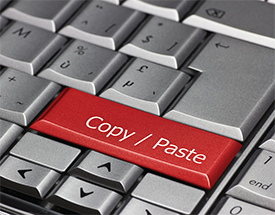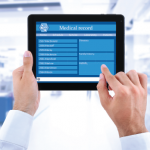
Image Credit: jurgenfr/SHUTTERSTOCK.COM
Case
You’ve been asked to see an inpatient for a rheumatologic consultation. After seeing the patient, you enter an initial consult note in the electronic medical record (EMR). The next day, when you write a follow-up note for this patient, you copy part of your assessment and plan from your prior note.
Soon after you sign your notes, you realize that your note has an error: It states that the patient had a total knee replacement on the left, when it was actually on the right. When you check other notes to confirm this, you find that one of the residents from a separate consulting team copied and pasted the majority of your history of present illness and past medical history verbatim, including the error regarding which knee had been replaced.
Discussion
The Health Information Technology for Economic and Clinical Health Act of 2009 (HITECH) has encouraged the use of EMRs. Further, in 2011, the U.S. government gave financial incentives to hospitals that established EMRs. Not only can EMRs improve coordination of care and decision making among providers, but they can also increase practice efficiency and savings, reduce medical errors and benefit clinical research.
On the other hand, the very nature of the electronic format gives rise to problems. EMRs allow physicians to copy and paste clinical documentation. Not only can physicians copy and paste from their own clinical notes (i.e., self-plagiarism), but they may also have the ability to cut and copy from other providers’ notes. This may be time saving for already time-starved physicians, but it may result in false documentation or the perpetuation of outdated or even incorrect clinical information. This misrepresentation of data may contribute to suboptimal care for patients or inappropriate billing.
Regardless of what guidelines or standards are developed in the future, it should be expected that all information that is ‘borrowed’ from other sources be carefully reviewed & edited for accuracy.
The use of plagiarism and self-plagiarism of medical documentation in EMRs is prevalent and rapidly increasing. Between 1993 and 2002, a study at the Veterans Administration (VA) found that 9% of notes reviewed in their EMRs had copied text, although copying has been reported as high as 20% in another VA study that examined only inpatient notes.1,2 Among the 44 notes placed in the highest risk category, labeled as “major potential risk of patient harm, fraud or tort claim exposure,” copying occurred most frequently in the exam (31 times) and the history of present illness (nine times). Over the last three years of the study period, the number of copy events almost tripled.1
There is a high prevalence of copying at academic centers as well. A survey conducted at two large, academic-affiliated hospitals revealed that 90% of the internal medicine and pediatrics residents and faculty who wrote notes electronically used the copy-and-paste function. Although 71% of these physicians agreed that notes written using the copy-and-paste function had inconsistencies and outdated information, a much smaller percentage of these physicians felt that it led to more confusion in patient status or course (27%) or was more likely to lead to a mistake in patient care (25%). The majority of physicians (82%) wanted to continue to use the copy-and-paste function.3
Copy and paste is also commonly used by attendings and residents in the intensive care unit (ICU). A study performed at an urban academic medical center with a 14-bed medical ICU found that copying occurred in 82% of all resident notes and 74% of all attending notes. Residents copied more frequently, but attendings copied more information between notes.4
Although EMRs are meant to enhance communication between providers, there is a fear that they are now overwhelming repositories of data that may be used to expand documentation for billing purposes. In 2012, the Obama administration issued a warning letter to chief executive officers, addressing the concerns around false documentation and potential “cloning” of medical records to receive higher reimbursements.5 Although the American Medical Association (AMA) does not comment specifically on plagiarism or “cloning” in EMRs, they do advise physicians to “make no intentional misrepresentations to increase the level of payment they receive or to secure non-covered health benefits for their patients.”6 Interestingly, a recent study found no evidence that hospitals were using EMRs to increase their Medicare reimbursements.7
We need professional standards for the use of the cut-and-copy function in EMRs. Such standards will need to address some challenging questions, including:
- Is it ethical to copy others’ medical documentation?
- Is it acceptable to self-plagiarize medical documentation?
- Is self-plagiarism more acceptable than plagiarism?
- Are there certain circumstances when self-plagiarism or plagiarism would be considered appropriate, and others when it is inappropriate?
Regardless of what guidelines or standards are developed in the future, it should be expected that all information that is “borrowed” from other sources be carefully reviewed and edited for accuracy. When extensive information is copied from another source, it may be best to provide attribution.
There is little doubt that EMRs can have a beneficial role in medical care. However, we must be careful not to use (or abuse) EMRs in a way that compromises patient care or diminishes trust in the medical profession.
Back to the Case
Upon recognizing the discrepancy regarding which knee was replaced, you issue an addendum to your initial note. You forward this addendum to the resident who had copied large parts of your note with a gentle reminder regarding the perils of copying and pasting. Although the patient in this case suffered no harm from the cutting and pasting of medical documentation, that may not be true the next time.
Jane S. Kang, MD, is an assistant professor of medicine and program director of the Rheumatology Fellowship at Columbia University Medical Center/New York Presbyterian in New York. She is completing a Masters of Bioethics at Columbia University.
Robert H. Shmerling, MD, is the clinical chief of rheumatology at Beth Israel Deaconess Medical Center in Boston and the chair of the ACR’s Committee on Ethics and Conflict of Interest.
Editor’s Note
If you have comments or questions about this case, or if you have a case that you’d like to see in Ethics Forum, e-mail us at [email protected].
References
- Hammond KW, Helbig ST, Benson CC, et al. Are electronic medical records trustworthy? Observations on copying, pasting and duplication. AMIA Annu Symp Proc. 2003;269–273.
- Weir CR, Hurdle JF, Felgar MA, et al. Direct text entry in electronic progress notes. An evaluation of input errors. Methods Inf Med. 2003;42(1):61–67.
- O’Donnell HC, Kaushal R, Barron Y, et al. Physicians’ attitudes towards copy and pasting in electronic note writing. J Gen Intern Med. 2009 Jan;24(1):63–68.
- Thornton DJ, Schold JD, Venkateshaiah L, et al. The prevalence of copied information by attendings and residents in critical care progress notes. Crit Care Med. 2013 Feb;41(2):382–388.
- Letter from Obama administration on hospital billing. The New York Times. 2012 Sep 24.
- AMA Code of Medical Ethics. Opinion 9.132—Health Care Fraud and Abuse.
- Adler-Milstein J, Jha AK. No evidence found that hospitals are using new electronic health records to increase Medicare reimbursements. Health Aff. 2014 Jul;33(7):1271–1277.


